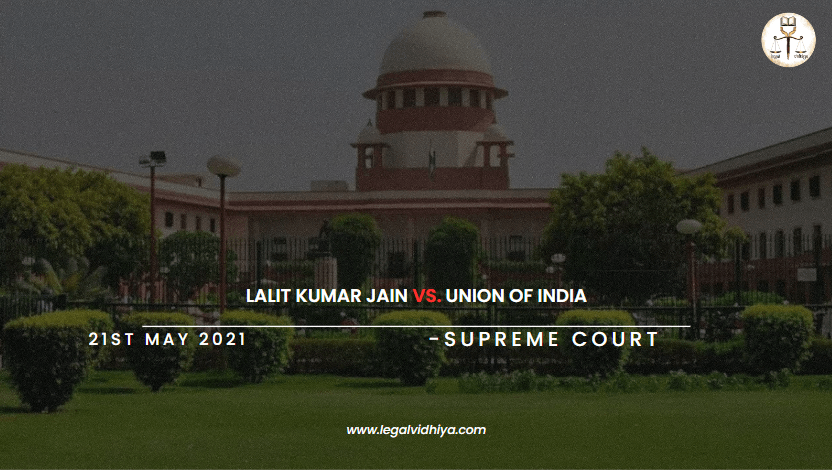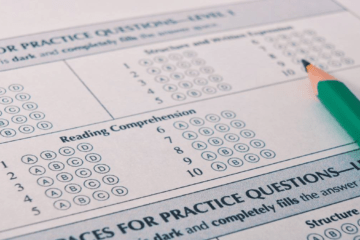
| Case Name | Lalit Kumar Jain Vs. Union of India |
| Citation | AIRONLINE 2021 SC 402 |
| Date of Judgement | 21st May 2021 |
| Court | SUPREME COURT OF INDIA |
| Respondent | UNION OF INDIA & ORS |
| Bench | S. Ravindra Bhat, L. Nageswara Rao |
Introduction
In Lalit Kumar Jain v. Union of India (UOI), 2021, the Central Government’s November 15, 2019, notification is being challenged in court. The announcement was especially on the rules about personal guarantors of corporate debtors under Part III of the Insolvency and Bankruptcy Code, 2016 (the Code). The petitioner, Lalit Kumar Jain, claimed that the Central Government had overreached its statutory authority granted by Parliament and that the notification went beyond the Code’s provisions.
The primary questions in this case concerned the legal validity of the contested notification and the Central Government’s authority to execute the aforementioned Code sections. The petitioner contended that when a corporate debtor’s resolution plan was approved, the notification led to an erroneous release of personal guarantors’ obligations.
In its decision, the Supreme Court maintained the notification’s legality and validity and declared that personal guarantors were still liable for their obligations even after a corporate debtor’s resolution plan was approved. The writ petitions were dismissed by the Court, and related cases and petitions were transferred without incurring any fees.
This case clarifies the distinction between the duties of corporate debtors and personal guarantors in the context of resolution plans under the Code, which has important ramifications for India’s bankruptcy and insolvency procedure.
Facts of the Case:
The legal problem in this instance relates to the legitimacy and legality of the notification that the Central Government released on November 15, 2019. Regarding the Insolvency and Bankruptcy (Application to Adjudication Authority for Insolvency Resolution Process for Personal Guarantors to Corporate Debtor) Rule, 2019, which went into effect on November 15, 2019, the Appelant has requested additional relief. Similarly, the Appelant contested the legality of the Insolvency and Bankruptcy Regulation issued on November 20, 2019.
Under Article 32 of the Constitution, several Writ petitions were filed in various High Courts claiming that the aforementioned challenged Notification had wronged them. However, the release of the advances to the companies was made possible by the Appelant’s guarantee that she had given to the banks and financial institutions. The individuals serving as personal guarantors were connected to the companies as directors, managing directors, and promoters. In numerous instances, the personal guarantees have been cited, and legal action has been taken against the companies that were linked to the bank guarantees. Both insolvency and recovery procedures were started in numerous instances. There are numerous cases where the resolution plans have been completed, but in some instances, the adjudicating body has not approved.
The Debt Recovery Tribunal has the authority to start the IBC action against the Personal Guarantors before this Notification.
Following this notification, the banks have the authority to start legal action, which will increase the personal guarantors’ obligation. The Creditors now have the authority to start an IBC action against the individual and personal guarantors as a result of this notification. Numerous petitioners received a variety of demand notices suggesting they begin the insolvency process under the Code, along with recovery actions following the guarantee’s invocation.
Issues Raised
- Does the case qualify for maintenance under Article 32 and Article 139A of the Constitution?
- Is the contested notification from the Ministry of Corporate Affairs legitimate?
3. If the Rules, 2019 (Application to Adjudicating Authority for Insolvency Resolution Process for Personal Guarantors to Corporate Debtor), which were released on November 15, 2019, are still valid.
Contentions of the Appellant
The petitioners argued that the Central Government’s notification constituted an act of “excessive delegation” and that it lacked the legislative or statutory authority to place restrictions on the Code’s enforcement. As a corollary, it was also argued that the Central Government’s powers were exceeded by enforcing Sections 78, 79, 94-187, etc. of the Code about personal guarantors alone, as stated in the contested notification.
Furthermore, it was contended that the government could not arbitrarily decide to limit the scope of the insolvency proceedings to the personal guarantors by Section 1(3) of the Insolvency and Bankruptcy Code, 2016. Therefore, the authority granted by Section 1(3) Insolvency and Bankruptcy Code, 2016 relates solely to the time(s) at which various Code provisions may be implemented; it does not enable the Central Government to announce the implementation of specific Code provisions or to restrict the application of such provisions to particular groups of individuals. However, the notice merely made notice of certain Code requirements since they applied to individual guarantors of corporate debtors; as a result, it was beyond the purview of the proviso to Section 1(3) of the Insolvency and Bankruptcy Code, 2016.
The Petitioners’ description of Section 1(3) of the Insolvency and Bankruptcy Code, 2016 as “conditional legislation” served as the foundation for their case. They assert that conditional legislation, in contrast to delegated legislation, is a limited authority that may be used once, about the subject matter or class of subject areas. The executive operates within its authority so long as multiple dates are set for the enactment’s enforcement, or so long as the executive acts about distinct areas. On the other hand, it engages in illegal legislation when it does so selectively and divides the enactment’s coverage into distinct categories.
The petitioners further contended that Section 243 of the Insolvency and Bankruptcy Code, 2016 which would have repealed the only two Acts that permitted the filing of insolvency proceedings against an individual, was not implemented by the Central government. As a result, there were now two legally incompatible procedures for the personal guarantors’ insolvency.
Furthermore, it was also asserted that a guarantor’s liability is coextensive with the principal debtors. However, by claiming in both the corporate debtor’s and the personal guarantor’s bankruptcy processes, the contested notification enables creditors to unfairly benefit themselves. Filing a “double recovery” lawsuit against both the corporate debtor and the personal guarantor would be against the Code. Accordingly, any obligation owed by its guarantors must likewise be extinguished, being coextensive by Section 128 of the Indian Contract Act, 1872, as the claims against the principal debtor are extinguished with the completion of the insolvency process.
Contentions of the Respondent:
The Union of India, the respondents, countered that the changes made to the Insolvency and Bankruptcy Code, 2016 in 2018 to include three classes of debtors—personal guarantors to the corporate debtor, partnership firms and proprietorship firms, and individuals—show that the Parliament has always wanted to treat personal guarantors differently from other individuals, proprietorship firms, and partnership firms. According to the respondents, there was a discernible difference between individuals and partnership/proprietorship firms as personal guarantors for corporate creditors.
Furthermore, the phrase “corporate guarantor or personal guarantor as the case may be” was added to Section 60(2) of the Insolvency and Bankruptcy Code, 2016. This suggests that a personal guarantor might be the subject of bankruptcy procedures, the outcome of which would be decided by the NCLT.
The respondents argued that to best accomplish the IBC’s goals, Section 1(3) of the Insolvency and Bankruptcy Code, 2016 should be interpreted with flexibility. To demonstrate that a stage-wise implementation was legitimate and not ultra vires, further reliance was placed on several decisions, including Basant Kumar Sarkar v. Eagle Rolling Mills Ltd and Bishwambhar Singh v. State of Orissa. This is because understanding the impact of the implementation is facilitated by these decisions.
Judgement:
After considering the arguments made by both parties, the Supreme Court ruled that the Notification does not constitute a “legislative exercise” or an illegal or discriminatory application of IBC provisions. The International Bank Guarantee Act does not require that it apply to everyone (including personal guarantors) at once or not at all. The Central Government intended for the Code to be implemented gradually while keeping in mind its goals and objectives, which are allowed by law.
According to the Supreme Court, it is possible to conclude that the earlier revisions were made to advance and bolster the IBC’s goals. The Apex Court further noted that NCLT served as the adjudicating body for corporate entities’ insolvency and liquidation, including corporate debtors and personal guarantors, even under the unamended IBC before 2018.
To consider the full picture of the nature of the assets accessible, whether during the corporate debtor’s bankruptcy procedure or even subsequently, the Supreme Court noted that the forum for adjudicating insolvency processes must be common, i.e., the NCLT. Furthermore, given the close relationship that exists between corporate debtors and personal guarantors, permitting bankruptcy processes involving the aforementioned parties to take place in different venues may result in unpredictable consequences that will undermine the Code’s intent.
The Supreme Court further ruled that “the sanction of a resolution plan and finality imparted to it by Section 31 of the Insolvency & Bankruptcy Code, 2016 does not per se operate as a discharge of the guarantor’s liability.” Based on its previous decisions, the Supreme Court noted: “the release or discharge of a principal borrower from the debt owed by it to its creditor, by an involuntary process, i.e. by operation of law, or due to liquidation or insolvency proceeding, does not absolve the surety/guarantor of his or her liability, which arises out of an independent contract”
The UK ruling was cited by the Supreme Court to clarify that a creditor may pursue legal action against the surety, the corporate debtor, or both. It was noted that a personal guarantee (of a corporate debtor) is not automatically released from their obligations under the guarantee contract just because a resolution plan has been approved.
The Supreme Court also pointed out that there has been no notification of Section 243 of the Insolvency & Bankruptcy Code, 2016, which allows for the repeal of personal insolvency rules. The IBC has superseding authority over other enactments, as stated in Section 238 of the Insolvency & Bankruptcy Code, 2016. Perhaps this is the reason for not informing Section 243 of IBC, 2016. In addition, if Section 243 of the IBC, 2016 is notified, the impugned notification would not cover proceedings that are pending against personal guarantors in other forums, defeating the purpose of bringing the proceedings under the purview of adjudicating authorities/IBC. Section 243(2) of the Insolvency & Bankruptcy Code, 2016 saves pending proceedings under the Presidency-towns Insolvency Act, 1909 and Provincial Insolvency Act, 1920.
Analysis
In my opinion, even though this ruling has opened up a new path under the Code, it can be challenging at first because, in many cases where the resolution plan is the subject of insolvency proceedings involving the personal creditors of the corporate debtor, it has either already been approved by the NCLT or the Committee of Creditors and is awaiting NCLT approval. It would be difficult to start the bankruptcy process over in that situation. In addition, the Code’s objective is to guarantee that the insolvency procedure is completed within the designated period.
Secondly, the case demonstrates that the Personal Guarantor’s obligations are not automatically discharged with the approval of the Resolution Plan. It binds all Creditors, Personal Guarantors, and Stakeholders equally. The Indian Contract Act of 1872 similarly reiterates the idea that “the surety’s liability is co-extensive with that of the principal debtor”. In addition, under Section 140 of the Contract Act of 1872, the Personal Guarantor is not allowed to exercise subrogation rights after the Resolution Plan is authorized.
Although the verdict will provide some relief to bankers, the chairman of many firms might experience restless nights as a result of it. Previously, banks were not allowed to file lawsuits against the individuals who personally guaranteed various companies; the majority of these individuals held positions as directors, chairmen, or promoters. An example of this may be seen in the Bhushan Steel and Power resolution, in which the promoters offered guarantees totalling approximately 24,550 crores. However, the banks were unable to pursue legal action against them in addition to the company’s bankruptcy process. It was an essential action, and the sustaining of the notice in this decision is a step in the right direction toward accomplishing the objectives of the IBC and reducing the quantity of non-performing assets.
Conclusion
The fact that the verdict was rendered with the IBC’s goals in mind is a positive development for the creditors. With a more complete debt recovery mechanism in place thanks to this verdict, NCLTs now have the authority to handle personal guarantors of corporate debtors alongside the CIRP (Corporate Insolvency Resolution Process) procedures of corporate debtors/principal borrowers. Because there would be a single process instead of two distinct ones to collect debts from guarantors and borrowers, the integrated procedure would also prevent individuals in charge from evading their responsibilities.
Conversely, the stance established by the Supreme Court in the current ruling, which favours creditors, has placed personal guarantors in a risky situation. In the case of Swiss Ribbons Private Limited Vs. Union of India, the Supreme Court emphasised that the Code’s goal is to guarantee the corporate debtor’s revival and cautioned against using it as a simple recovery tool. But at the expense of fundamental contract and legal foundations, the current “creditor-centric model” has produced just that.
Because the Code permits creditors to pursue recovery of their debts against personal guarantors without granting the latter the corresponding right of subrogation, it has effectively turned into a tool in their favour. Furthermore, the resolution plan under Section 30 of Insolvency and the Bankruptcy Code, 2016 is approved by the creditors themselves through the Committee of Creditors (CoC), leaving the guarantor with little legal remedy if his contractual rights are terminated.
References:
Varun Pandey, https://www.fiducialegal.in/post/case-brief-lalit-kumar-jain-vs-union-of-india-ors
Ayushi Srivastava, https://www.sndlegalassociates.com/post/case-analysis-lalit-kumar-jain-vs-union-of-india
https://blog.ipleaders.in/lalit-kumar-jain-v-union-india-analysis/
Case laws:
1. Basant Kumar Sarkar v. Eagle Rolling Mills Ltd
2. Bishwambhar Singh v. State of Orissa
3. Swiss Ribbons Private Limited Vs. Union of India
Written by Vikas Sharma an intern under legal vidhiya.
Disclaimer: The materials provided herein are intended solely for informational purposes. Accessing or using the site or the materials does not establish an attorney-client relationship. The information presented on this site is not to be construed as legal or professional advice, and it should not be relied upon for such purposes or used as a substitute for advice from a licensed attorney in your state. Additionally, the viewpoint presented by the author is of a personal nature.




0 Comments